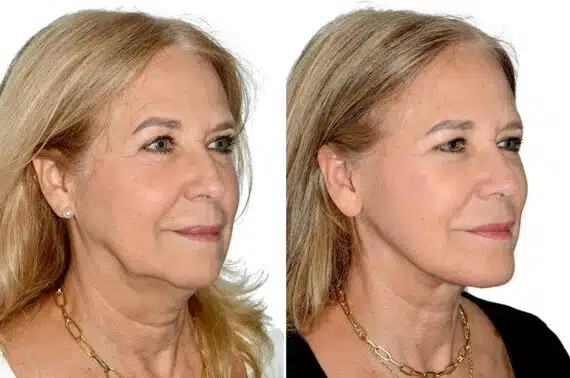Getting older is just part of life—but that doesn’t mean you have to look or feel older than you are. A facelift at 50 can be a great way to refresh your appearance and feel more like yourself again. Thanks to modern techniques, it’s now easier and gentler than ever.
Many women in their 50s are choosing facelifts to boost their confidence and bring back that youthful glow. With more people opening up about cosmetic treatments, choosing a facelift at 50 is becoming a normal—and empowering—step toward feeling your best.
.

Why 50 is the Perfect Age for a Facelift
A facelift at 50 just makes sense. It’s the age when signs of aging really start to show, but your skin still heals well. That means you can get great results that look fresh—not fake.
- Tech Has Come a Long Way: Today’s facelifts are subtle, with small scars that are easy to hide.
- You’re Starting to See Changes: Things like sagging skin and deeper lines become more noticeable.
- Your Skin Still Bounces Back: At 50, your skin is strong enough to heal nicely after surgery.
- You’ll Enjoy the Results Longer: Doing it now means looking good for years to come.
- It Feels Good to Look Refreshed: When you like how you look, you naturally feel more confident.

Facelifts After 50—A New Beginning
The road toward rejuvenation begins with the understanding that facelifts are no longer a luxury reserved for the rich and famous.
These days, Middle-aged women over 50 are realizing more and more how important is to recover their youthful appearance and increase their confidence.
Advanced surgical procedures including the benefits of getting a deep plane facelift in Miami , SMAS facelift, mini facelift have changed the field of facial plastic surgery.
Expert plastic surgeons carry out these operations as a fresh start to fight the consequences of the natural aging process.
Why Women Over 50 Are Opting for Facelifts
✅ Addressing Common Signs of Aging
- Natural aging leads to sagging skin, volume loss, and deeper wrinkles.
- Facelifts help tighten loose skin and restore facial definition.
- Advanced techniques ensure natural-looking, long-lasting results.
✅ Boosting Self-Confidence
- Many women seek facelifts to enhance their self-image.
- A rejuvenated appearance can positively impact social and professional life.
- Feeling youthful on the outside often aligns with inner vitality.
✅ Advancements in Facelift Procedures
- Modern facelifts offer minimally invasive options with quicker recovery.
- Techniques like deep-plane facelifts and fat grafting provide enhanced, natural results.
- Less scarring and improved safety make the procedure more appealing.
✅ Growing Social Acceptance & Awareness
- Plastic surgery has become more normalized and widely accepted.
- More celebrities and public figures openly discuss their positive experiences.
- Women are better informed about their options, leading to more educated decisions.
What Are the Facelift Benefits for People Aged 50?
A facelift at 50 can do more than just improve how you look—it can help you feel more like yourself again. Here’s what it can offer:
- Improves Facial Balance: Brings back natural harmony to your features, so everything looks refreshed—not overdone.
- Tightens Loose Skin: Lifts the neck and jawline for a smoother, firmer look.
- Restores Facial Volume: Adds back fullness in areas like the cheeks for a softer, youthful appearance.
- Reduces Deep Wrinkles: Helps smooth out lines around the mouth and nose.
Real-life Transformations: Before & After Facelift Photos
Looking at actual changes is one of the best approaches to grasp the possible advantages of a facelift. Previous before and after photos of facelift patients can help one visually understand what this operation can do. These changes can be quite amazing; many individuals seem years younger following surgery.
Each patient is unique and individual results may vary*.
Curious About Famous Facelift Before and After Transformations?
It’s always interesting to see how others have handled aging—especially familiar faces. These well-known women chose to have a facelift around age 50, and they’ve been open about their experiences. Their stories give a real look at what’s possible when the procedure is done with care.

1. Kris Jenner
Around 55
Facelift, neck lift, laser treatments
Kris Jenner has always been open about her cosmetic procedures and even documented her facelift on Keeping Up with the Kardashians. The results were stunning, giving her a youthful and refreshed look while maintaining her natural expressions. Her lifted jawline and smooth skin have contributed to her signature polished appearance.

2. Sharon Osbourne
Mid-50s
Multiple facelifts, eyelid surgery, brow lift
Sharon Osbourne has openly embraced cosmetic enhancements, achieving a rejuvenated and refined look. Her facelifts have helped her maintain a fresh and lively appearance, complementing her vibrant personality. She has continued to look elegant and youthful, making her one of the most well-maintained figures in entertainment.

3. Jane Fonda
Around 55
Facelift, eyelid surgery
Jane Fonda has always prioritized looking and feeling her best. Her facelift gave her a beautifully natural and refreshed look, enhancing her signature elegance. She has maintained a graceful, youthful appearance over the years, continuing to inspire confidence and beauty in aging.
Facelift Options Tailored for the 50+ Woman
✅ Traditional Facelift
- Ideal for full-face rejuvenation.
- Tightens skin and underlying muscles.
- Restores volume and enhances facial contours.
✅ Deep-Plane Facelift
- Repositions deeper tissues for a long-lasting, natural result.
- Addresses significant sagging and volume loss.
- Produces a softer, youthful appearance.
✅ Mini Facelift
- Less invasive with quicker recovery.
- Targets mild to moderate sagging.
- Provides subtle but noticeable lift.
✅ Additional Enhancements
- Fat grafting for restoring lost volume.
- Laser resurfacing to improve skin texture and tone.
- Neck lift for comprehensive rejuvenation.
Talk to your surgeon about your cosmetic objectives, concerns, and the appropriate sort of facelift you would want. Prepare yourself to provide your medical background, including any past facelift procedures or rejuvenation treatments.
This material will enable your surgeon to choose the best surgical approaches for your facelift operation. Ideally a board-certified facial plastic surgeon with a lot of experience in facial rejuvenation techniques, your surgeon should help you sort through the several facelift alternatives.
Questions about your procedure?
Schedule a consultation with Dr. Andres Bustillo.
How Can You Recover Smoothly After a Facelift at 50?
A smooth recovery makes all the difference. Here are simple tips to help you heal well and feel great after your facelift:
Right After Surgery
- Rest with Your Head Up
Prop yourself up with pillows—this helps reduce swelling. - Use Cold Compresses
Gently ease swelling and discomfort (but don’t put ice right on your skin). - Take Your Meds
Use pain medicine as prescribed. Skip aspirin—it can cause bleeding. - Stay Hydrated
Drink lots of water. It helps your body heal faster.
Ongoing Care
- Go to All Follow-Ups
Your surgeon will make sure everything’s healing just right. - Be Gentle with Your Skin
Use mild skincare only. No harsh scrubs or strong creams until your doctor says it’s okay. - Protect from the Sun
Use sunscreen and wear a hat. Sunburn can slow healing and affect scars.
Lifestyle Tips
- Eat Well
Load up on fruits, veggies, and lean protein—your skin will thank you. - Skip Smoking & Alcohol
Both can slow healing and affect your results.
Risks and Considerations for Facelifts After 50
Facelifts may involve some risks, just like any surgical operation. Among these can be bleeding, infection, inadequate healing of wounds, and anesthesia-related problems. One can also have transient or permanent changes in face asymmetry or feeling. Talk to your surgeon about these risks.
Common Risks
Temporary and expected but can be minimized with proper care.
Typically minimal and well-hidden, but can be reduced further with diligent wound care and avoiding sun exposure.
Serious Risks
Rare but serious, preventable with proper wound care and following your surgeon’s instructions. Look for signs like increased redness, swelling, or discharge, and contact your surgeon if these occur.
Very rare, but choosing a highly experienced and board-certified surgeon significantly reduces this risk.
Mitigation Strategies
Verify credentials and look for a board-certified plastic surgeon with extensive facelift experience.
To enhance safety and outcomes, strictly follow all pre- and post-operative guidelines provided by your surgeon.
Embrace a New You with Facelifts After 50
Making the personal decision to undergo a facelift following 50 will greatly enhance your appearance and confidence. A facelift can help you look as young and vibrant as you feel by correcting the visible signs of aging. This is an opportunity to welcome a fresh you and savor the advantages of this life-changing procedure. Please get in touch with us and arrange a consultation to start your facelift journey.
FAQs Relevant to Facelifts After 50?
Typically, patients resume normal activities two to three weeks post-facelift surgery. Recovery time varies based on the individual and facelift type.
Women over 50 often exhibit advanced aging signs, necessitating extensive procedures like deep plane facelifts or SMAS facelifts for desired results. Reduced skin elasticity in older women may influence the healing process and surgery outcome.
Common facelifts for women over 50 are the traditional, mini, and deep plane facelifts. The ideal facelift depends on individual goals and facial aging extent.
Though all surgical procedures carry risks, facelifts after 50 don’t have age-specific risks. However, existing health conditions could impact surgery or recovery, so discussing your medical history with your surgeon is crucial.
Facelift results can last for years, but they do not stop aging. Your face will naturally age post-procedure. A healthy lifestyle and skin care can prolong your facelift’s effectiveness.
Preparation includes stopping certain medications, avoiding smoking and alcohol, and following your surgeon’s specific instructions regarding diet and skincare. Preoperative instructions aim to ensure a smooth surgery and recovery process.
You can maintain results by following a healthy lifestyle, protecting your skin from sun damage, using quality skincare products, and attending regular follow-up appointments with your surgeon.



